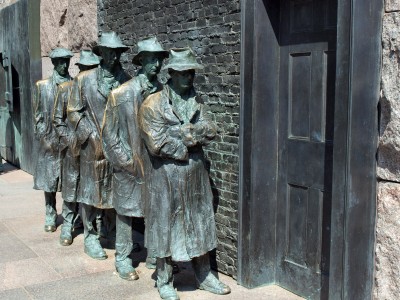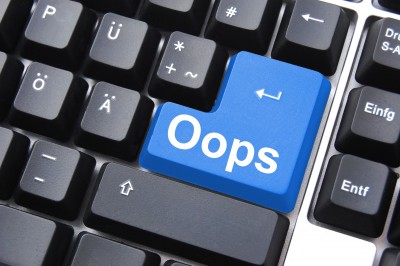Answer #1 to the Question What Is a Bear Market and What Is a Bull Market? — They Are NOT Short-Term Ups and Downs in Stock Prices

Much confusion about what is a bear market and what is a bull market is caused by a failure to distinguish short-term price movements from long-term upward or downward trends. The U.S. stock market has been in a bear market since January 2000. That means that stock prices have been working their way downward for ten years now and will likely continue working their way downward for some time to come (this article was posted in March 2010). However, prices have moved upward since March 2009. The latter phenomenon is often referred to as “a bull market” but it really should be given a different label since it has nothing in common with the true bull market that we experienced from 1975 through 2000.
Some stock price changes have long-term significance and some do not. The general rule that you must focus on is that stock prices are always headed on a long-term basis in the direction of fair value. Thus, you should set your stock allocation with an expectation that prices will be headed downward if they are high and upward if they are low. In contrast, short-term moves upward or downward are insignificant and should be ignored. The smart investor tunes out short-term price changes and sets his stock allocation by making reference to long-term trends. So it is a mistake to think of short-term bull or bear moves as being similar to genuine (long-term) bull or bear moves. These are very different phenomena.
Many stock investors who lost money in the stock crash of September 2008 are taking comfort in the fact that prices have traveled upward since then. This is a mistake. We are still in a long-term bear (often referred to as “a secular bear market”). Thus, the effect of any temporary move upward is likely to be canceled out by larger downward price movements that will be taking place in future days. In fact, the more that prices go up, the greater will be the pressure created for stronger and deeper price drops. Today’s stock investors are hurting themselves by cheering on upward price movements and should instead be seeking a stabilization in prices or even modest price drops, which would diminish the risks of further crashes.
If you would like to review the historical data for yourself to come to a better understanding of how the bull/bear cycle works and of what is a bear market, please check out the “Stock Market Data” section of Robert Shiller’s web site.
Answer #2 to the Question What Is a Bear Market or a Bull Market? — They Are Both Dangerous Self-Accelerating Phenomena

Many investors cheer on bull markets because they cause temporary gains in portfolio values. This is a mistake. Bull markets are caused by investor emotion. Thus, it is almost impossible to control a bull market. Unjustified price increases cause investors to become even more emotional and the added emotion then causes even more unjustified price increases. When a market enters a bull stage, it has given up much of its rationality, and the tendency of a market that has lost much of its rationality is to lose even more of its rationality. Any bull move (that is, any price increase not justified by the economic realities) causes further bull moves.
The same is true with bear markets. It is also emotion that causes prices to drop below fair value. And, again, emotional price drops cause investors to become depressed, which causes even more emotional price drops. Bear markets are also dangerous, just in a different way than bull markets.
Answer #3 to the Question What Is a Bear Market or a Bull Market? — Both are Self-Cancelling Phenomena
This gets tricky. Bull markets cause even greater bull markets. And bear markets cause even greater bear markets. Until they don’t.
Out-of-control bull markets cause bear markets. And out-of-control bear markets cause bull markets.
Yes, it is a bit confusing. But it does make sense if you think over for a moment the implications of the reality that both bull markets and bear markets are entirely emotional phenomena.
Say that you are a moderate drinker. You drink perhaps a glass or two of beer a week or perhaps a glass or two of wine. What sort of drinker are you likely to be a year from today? The odds are that you will remain a moderate drinker. So long as your drinking habit is a moderate one, it is likely to remain more or less what it has long been.

Now imagine that you are an alcoholic, that you drink a six-pack every night after work. Now what sort of drinker are you likely to be a year from today? Someone who drinks a six-pack a day is on the road to becoming an alcoholic and is likely to be moving farther down that road as time passes. The heavy drinker is likely to be an even heavier drinker after the passage of some time. Like a bull market, heavy drinking is self-accelerating.
But drinking cannot continue becoming heavier and heavier indefinitely. At some point, the alcoholism causes such problems that the drinker is faced with a choice of either killing himself with drink or giving up drink altogether. Excessive drinking increases to the point at which it can no longer increase and then leads to adoption of a drinking habit just as extreme but in the opposite direction. Heavy drinkers usually have to give up drink altogether because the out-of-control nature of their habit rules out the possibility of moderation of the habit.
So it is with bull markets. Bull markets push stock prices to more and more and more insane levels and then cause crashes. It is not possible for insane markets to moderate themselves. Why? Because bull markets are fueled by investor emotions and intensely emotional investors are not open to the consideration of reason, which is a necessary part of any move to moderate prices. Out-of-control bull markets almost always lead to out-of-control bear markets. It would be fair to say that out-of-control bull markets are the cause of out-of-control bear markets.
Answer #4 to the Question What Is a Bear Market and What Is a Bull Market? — Both Are Entirely Emotional Phenomena
The fair-value price for stocks is the discounted value of the future earnings stream generated by the underlying companies. Going back as far as we have records, the average long-term return for U.S. stocks has been 6.5 percent real. So stock prices need to increase 6.5 percent real each year to cover the productivity gains for the year.
Any gains beyond that amount are the product of investor emotion and unsustainable in the long term. Investors should not be cheered by excess gains. They need to be paid back in future years. An investor counting his bear market stock gains as real is like a debtor getting excited because of his additional “earnings” in a year when he took on a lot of credit-card debt. Borrowed money is not real wealth and neither are bull-market stock gains.
The same is of course true of bear market losses. Just as excessively high stock prices must fall to fair value, excessively low stock prices must rise to fair value. So bear market losses are no more real than bull market gains.

Don’t count the money you “earn” in a bull market (above that reflecting the economic realities) as real. And don’t count the money you “lose” in a bear market as real. What investor emotion gives in a bull market it takes back in the bear market that inevitably follows.
Answer #5 to the Question What Is a Bear Market and What Is a Bull Market? — They Both Compromise the Free Market
Free markets are wonderful. But markets do not yield their benefits by magic. There are preconditions to the effective functioning of a free market. One essential precondition is that participants in the market be sufficiently informed as to what is in their best interest to make effective financial decisions. That becomes impossible both in bull markets and in bear markets.
Say that an investor is at an age where be needs $200,000 in savings to be on track with his retirement plan and that his stock portfolio is nominally valued at $300,000. This investor would be tempted to believe that he is able to afford to buy a bigger house or a newer car or to go on a more expensive vacation than those he has gone on in the past. Now say that stocks are at the time priced at three times fair value (as they were at the top of the bull market of the 1990s). This investor’s portfolio is really comprised of $100,000 of real lasting wealth and $200,000 of cotton-candy nothingness fated to be blown away in the wind during the coming bear market. He is not far ahead in his efforts to finance his retirement but far behind.

This investor hurts not only himself when he spends money that he cannot afford to spend. He also undermines the functioning of the free-market economy. The purpose of the free market is to allocate resources to businesses that are doing a good job of satisfying consumer needs. But investors who are prompted by bull market prices to spend excessively cause rewards to be delivered to companies selling luxury goods at the expense of companies selling lower-priced goods. A functioning market would reward the companies responding to the real needs of consumers but the phony bull-market wealth causes funds to be misdirected to companies that properly would thrive only in an economy in which real incomes were higher.
Answer #6 to the Question What Is a Bear Market and What Is a Bull Market? — They Are Both Wealth Destroyers
Bull markets are wealth destroyers. They cause people to spend money that they do not possess in any real sense. Then when the phony bull-market funds disappear in the bear market that always follows a bull market, they cause the overspenders to become worried about their financial futures and thus reduce spending to lower-than-proper levels. Both overspending and underspending do harm to the economy and thereby destroy wealth.
A simple answer to the question “What is a bear market and what is a bull market?” is “Both are no darn good!”
Answer #7 to the Question What Is a Bear Market and What Is a Bull Market? — They Are Both Evidence That Buy-and-Hold Investing Can Never Work for the Long-Term Investor
The Buy-and-Hold Model for understanding how stock investing works is rooted in a belief that investing is a rational endeavor. If stocks could become overvalued, it would not make sense for investors to remain at the same stock allocation at all times (since the long-term value proposition of owning stocks is obviously less at times of overvaluation). Buy-and-Hold posits that overvaluation is impossible because it is not rational. Investors should value stocks properly, Buy-and-Hold advocates argue.
Investors should indeed value stocks properly. That much really is so. What Buy-and-Holders ignore is that investing is done by humans and humans are as much emotional as they are rational. Many investors do not want to invest rationally despite the financial penalties that follow from failing to do so. So during bull markets social taboos against reporting on the realities of stock investing are adopted to prevent those engaging in emotional investing from having to come to terms with their emotional investing decisions.
Answer #8 to the Question What Is a Bear Market and What Is a Bull Market? — Neither Are Required, Both Are Choices

Bull markets and bear markets don’t just happen. Bull markets happen because investors like the idea of voting themselves raises and elect to push stock prices up to unsustainable levels. Bear markets happen because prices must drop once they reach insanely high levels and the price drop depresses investors, causing the drops to be deeper than is necessary. There are no economic forces that require us to endure bull markets or bear markets.
Markets function best when participants are well-informed as to the pros and cons of the choices available to them. We could end both bull markets and bear markets by providing investors with tools that teach them the realities of stock investing. For example, if we explained to investors that “Staying the Course” in a meaningful sense requires an investor to lower his stock allocation when stock prices reach insanely dangerous levels, bull moves would cause stock sales, which would bring prices back down to reasonable levels. Stock prices are self-correcting for so long as investors are warned of the danger of giving in to their Get Rich Quick impulses and permitting bull markets to get out of control.
We all would be better off if there were no bull markets or bear markets, if stock prices increased by the 6.5 percent real justified by the economic realities. In that world, we would obtain the good of stock investing (high returns) without having to endure the bad (price volatility). All that we would have to do is to permit (and encourage!) investors to learn what they need to learn to invest effectively for the long run. That is, we would need to discourage the promotion of Buy-and-Hold, the investing philosophy that encourages investors to give in to their Get Rich Quick impulses and make no allocation shifts even when stock prices rise to insanely dangerous levels.
The great irony is that Buy-and-Hold assumes investor rationality while making investor rationality impossible (by discouraging investors from changing their stock allocations in response to big price changes). We can bring the bull/bear cycle to an end by encouraging our fellow investors to take stock prices into consideration when setting their stock allocations.
Answer #9 to the Question What Is a Bear Market and What Is a Bull Market? — Both Cause Economic Crises
Each of the four bull markets experienced from 1900 forward caused an economic crisis. We have never experienced an economic crisis during that time that was not preceded by a bull market. The bull market causes the crash that causes the bear market that eats up even more middle-class wealth and reduces spending to a point at which the economy can no longer function.
Answer #10 to the Question What Is a Bear Market and What Is a Bull Market? — They Are Change Agents

The economic crises brought on by the bull market/bear market cycle force the societies enduring them to change in fundamental ways. The bull market of the 1920s brought on The Great Depression, which led to adoption of the New Deal. The bull market of the 1960s brought on the stagflation of the 1970s, which led to Reaganomics.
The bull market of the 1990s led to today’s economic crisis, which has so far brought us the Tea Party Movement and which I believe in coming days may lead to a shift from the Buy-and-Hold Model for understanding how stock investing works to the Rational Investing Model (the Rational Model posits that investors must change their stock allocations in response to big price changes in an effort to keep their risk profiles roughly constant). A shift to Rational Investing strategies would greatly diminish the risks of stock investing and permit the free market to do a far more effective job of properly allocating capital, possibly ushering in a time of great economic growth and the Golden Age of Middle-Class Investing. That’s if we can survive the additional stock crashes that may be needed to persuade Buy-and-Hold advocates to admit the mistake they made in thinking that the market is immediately efficient rather than gradually so. Let’s all say a prayer!
